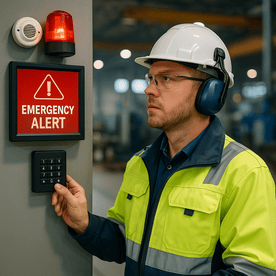
When an emergency strikes on the factory floor—whether it’s a gas leak, electrical fire, or chemical spill—seconds matter. But in many manufacturing facilities, the emergency response systems are still siloed. Your fire alarm goes off… but your access control system doesn’t react. A gas sensor trips… but no one knows if the plant’s exits are blocked.
This disconnect puts lives and operations at risk.
Manufacturers today need fully integrated emergency alert systems that unify fire detection, gas monitoring, surveillance, and access control into one cohesive response. Not just to improve safety—but to ensure the right people can act fast, and everyone else stays out of harm’s way.
l
l
Why Emergency Alert Integration Matters
Let’s start with what happens when systems aren’t connected.
Say your fire panel is triggered. You get a building-wide alarm—but:
-
Doors may stay locked (or unlocked), depending on how they’re configured
-
Safety staff may not know where the hazard started
-
Emergency exits may not be monitored
-
There’s no automated lockdown for unaffected zones
-
First responders may lack real-time visibility of the situation
In an industrial environment with flammable materials, moving machinery, or pressurized systems, every moment of confusion compounds the danger.
With an integrated emergency management system, these issues are addressed head-on.
l
l
How Integration Works in Real Manufacturing Environments
SSP works with manufacturers to design security systems that talk to each other—so when an emergency occurs, multiple layers of response are triggered in real time.
Here’s how that looks in practice:
🔥 Fire Alarm + Access Control
When a fire is detected, designated doors automatically unlock to allow safe egress—while others may lock to contain the hazard or restrict entry.
🧪 Gas Detection + Camera Alerts
If a gas sensor picks up a leak, your system notifies operators, restricts access to affected zones, and triggers surveillance to start recording—pinpointing the source of the leak and confirming evacuation progress.
🚨 Manual Duress or Panic Button + Sitewide Broadcast
A worker triggers a duress button in a remote corner of the plant. Instantly, strobe lights, intercoms, and digital signage alert the floor, while security teams get real-time camera views of the area.
👷 Badge Data + Mustering Reports
During evacuation, your access control system logs who has exited the building and who hasn’t—critical data for emergency responders.
l
l
Key Components to Integrate
If you’re evaluating your emergency systems, consider these integration points:
-
Fire Alarm Panel → Sends alerts, activates strobes, unlocks doors
-
Gas Sensors / Environmental Monitors → Triggers access lockouts and HVAC control
-
Access Control System → Controls badge-based entry and exit, creates digital logs
-
Intercoms & PA Systems → Delivers voice instructions during emergencies
-
Surveillance Cameras → Provide visual confirmation and incident documentation
-
Mass Notification Software → Sends alerts via text, email, or app to employees and leadership
-
Emergency Mustering Tools → Tracks who is accounted for and who’s still inside
When all of these systems work in concert, your facility can respond faster, reduce confusion, and potentially save lives.
l
l
Benefits of Emergency System Integration for Manufacturers
-
Faster Response Times
Automation ensures that alerts reach the right people—and the right systems—without delay. -
Reduced Human Error
Integrated systems remove the need to activate alarms, unlock doors, and communicate instructions separately. -
Improved Safety Compliance
Meeting OSHA, NFPA, and ISO standards becomes easier with documented response protocols and real-time audit trails. -
Lower Risk Exposure
When incidents are contained quickly and efficiently, injury rates and property damage are reduced—protecting people and your bottom line. -
Support for Remote Management
Integrated systems can often be accessed remotely, allowing safety leaders to monitor, alert, and control access offsite if needed.
l
l
SSP’s Approach to Emergency System Integration
At SSP, we specialize in building custom, scalable safety systems for industrial and manufacturing clients. That includes:
-
Tying existing fire panels into access control and camera systems
-
Setting up role-based alert protocols for different emergency types
-
Installing smart intercoms, mass notification displays, and mobile alert tools
-
Creating automated evacuation and mustering workflows
We work closely with plant managers, EHS leaders, and IT/security teams to make sure all systems function seamlessly—not just during a drill, but when it counts.
l
l
Final Thoughts
Emergency planning is only as strong as the systems that support it. If your fire alarm, gas detection, and access control systems don’t talk to each other, your facility is vulnerable to confusion, delays, and preventable harm.
In 2025, manufacturers can no longer afford disconnected safety tools.
If you're ready to connect the dots across your emergency infrastructure, SSP can help you build an integrated solution tailored to your facility’s needs.
Want to assess your current emergency response capabilities?
Schedule a safety integration review with SSP.


